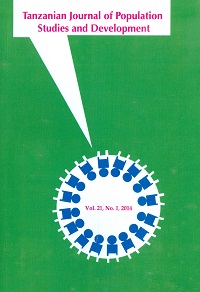Control of Soil Erosion in Mzinga River Catchment In the Uluguru Mountains, Tanzania: Approaches and Practices
Abstract
Soil erosion is a serious problem in Tanzania that leads to land degradation and rapid siltation of water reservoirs and water supply structures. This paper presents findings from a project initiated in 2003/2004 to rehabilitate the Mzinga River Catchment. The objective of the project was to rehabilitate the highly degraded catchment in order to improve peoples ' economic well being by imparting knowledge of raising tree seedlings in nurseries, growing forest and fruit trees, practicing agroforestry, and by establishing mechanical conservation works. The catchment conservation approach adopted was land user free choice in collaboration with community conservation committee and other key stake holders. Soil erosion measurements were done on fields, fallow lands, and semi-natural vegetation areas to monitor land use practices that contribute greatly to catchment degradation. Sediment yield modelling was done to determine rates of sediment yields from the catchment. The study results show very high soil erosion rates (up to more than 33 tons/ha) on agricultural lands, and sediment yields from the Mzinga river catchment of about 17 tons/ha per year. The study showed that conservation activities need extension to overcome the bad historical experiences of the communities in the catchment area, and to have more farmers adopting appropriate soil conservation measures after demonstrated increased productivity and economic benefits that will be achieved through good land husbandry practices and planted forest and fruit trees.
References
Christiansson, C., 1981. Soil erosion and sedimentation in semi-arid Tanzania. Studies of environmental change and ecological imbalances. Scandinavian Inst. African Studies, Uppsala and Depart. of Phy. Geogr., Univ. of Stockholm.
Johansoon, L., 2001. Ten million trees later: Land use change in west Usamabara mountains. The soil erosion control and agroforestry project in Lushoto District 1981-2000.
Kimaro, D. N., 2003. Assessment of major forms of soil erosion in the Morningside catchment, Uluguru mountains, Tanzania. PhD thesis, Sokoine Univ. of Agric.
Liu, B. Y.; Nearing, M. A.; and Risse, L. M. 1994. Slope gradient effects on soil loss for steep slopes. Trans. ASAE Vol. 37(6).
McCool, D. K.; Brown, L. C.; Foster, G. R.; Mutchler, C. K., and Meyer, L. D., 1987. Revised steepness factor for the Universal Soil Loss Equation. Trans ASAE 30 (5).
McCool, D. K.; Foster, G. R.; Mutchler, C. K., and Meyer, L. D., 1989. Revised slope length factor in the Eniversal Soil Loss Equation. Trans ASAE 30 (5).
Moore, T. R., 1979. Rainfall erosivity in East Africa. Geografiska Annaler, 61A, 3 €“ 4.
Morgan, R. P. C., 1988. Soil erosion and conservation, Longmans.
Mulengera, M. K., 1996.Soil loss prediction in the semi-arid Tropical savanna zone: A tool for soil conservation planning in Tanzania. PhD thesis, Univ. of Newcastle upon Tyne.
Mulengera, M. K. and Payton, R. W., 1999. Estimating the USLE €“ soil erodibility factor in developing tropical countries. Trop. Agric. (Trinidad) Vol. 76 No. 1.
Mulengera M. K., 2008. Sediment yield prediction in Tanzania: Case study of Dodoma district catchments. Accepted for publication in Tanzania J. of Eng. & Tech. Vol. 2(1).
Rapp, A.; Axelsson, V.; Berry, L., and Murray €“ Rust, D. H., 1972. Soil erosion and sediment transport in the Morogoro river catchment, Tanzania. Geografiska Annaler 54(3-4).
Renard K. G., Foster, G. R.; Weesies, G. A., and Porter, J. P., 1991. RUSLE: Revised universal soil loss equation. J. Soil & Water Conservation.
Shaw E. M., 1985.Hydrology in Practice. Van Nostrand Reinhold (UK) Co. Ltd.
Troeh, F. R., Hobbs, J. A., and Donahue, R. L., 1991. Soil and Water Conservation, 2nd Ed. Prentice Hall, Inc. Englwood Cliffs, New Jersey.
Walling, D. E. 1988. Measuring sediment yield from river basins. In: Lal, R. (Ed) Soil erosion Research Methods. SWCS, Ankeny, Iowa.
Williams, J. R., and Berndt, H. D., 1977. Sediment yield prediction based on watershed hydrology. Trans. ASAE Vol. 20(6).
Williams, J. R., and Berndt, H. D., 1972. Sediment yield computed with universal eqation. J. Hydr. Div., ASCE 98 (HY 12).
Wishmeier, W. H. and Smith, D. D., 1978. Predicting rainfall erosion losses €“ A guide to conservation planning. USDA, Agric. Handbook No.537.


